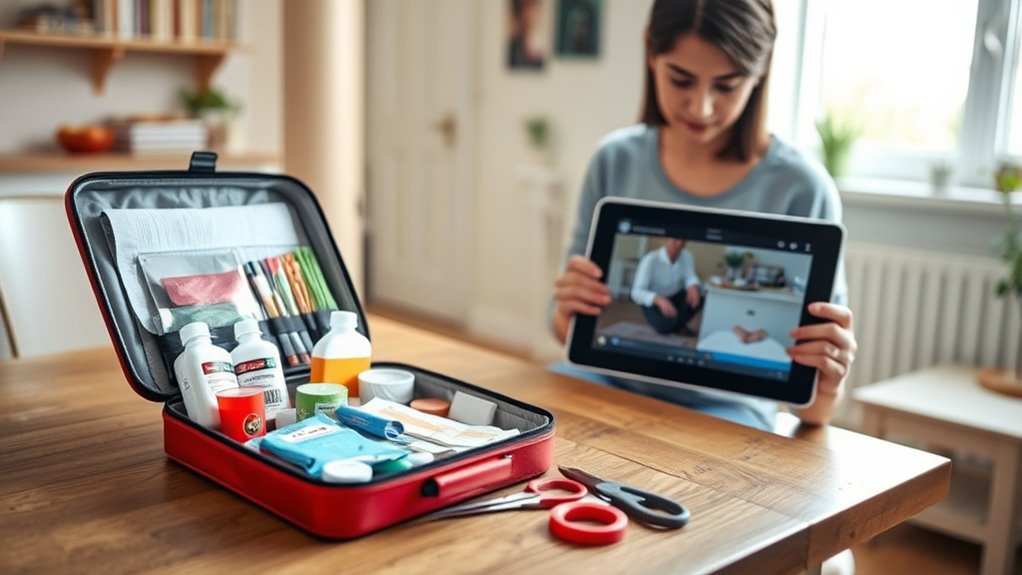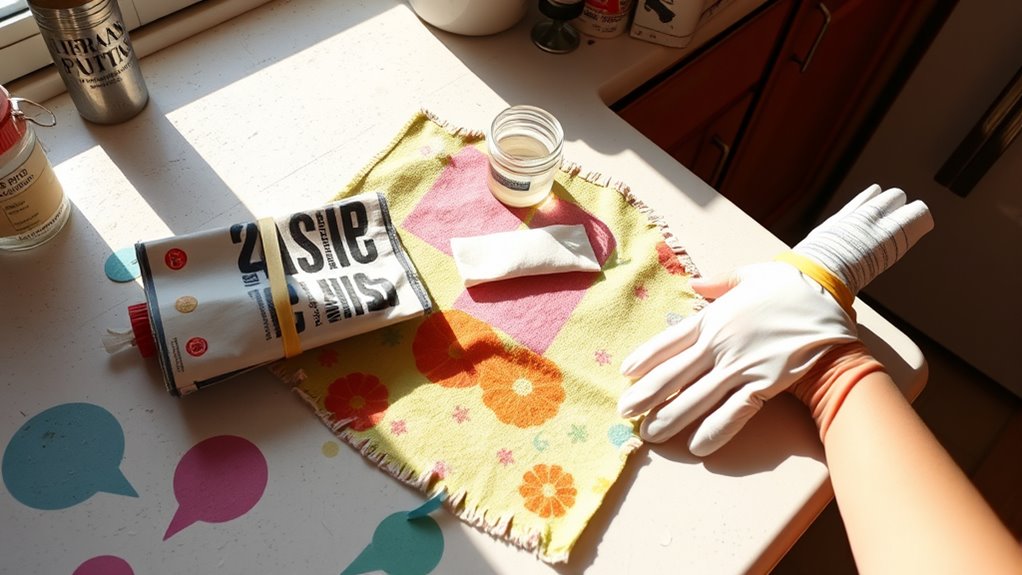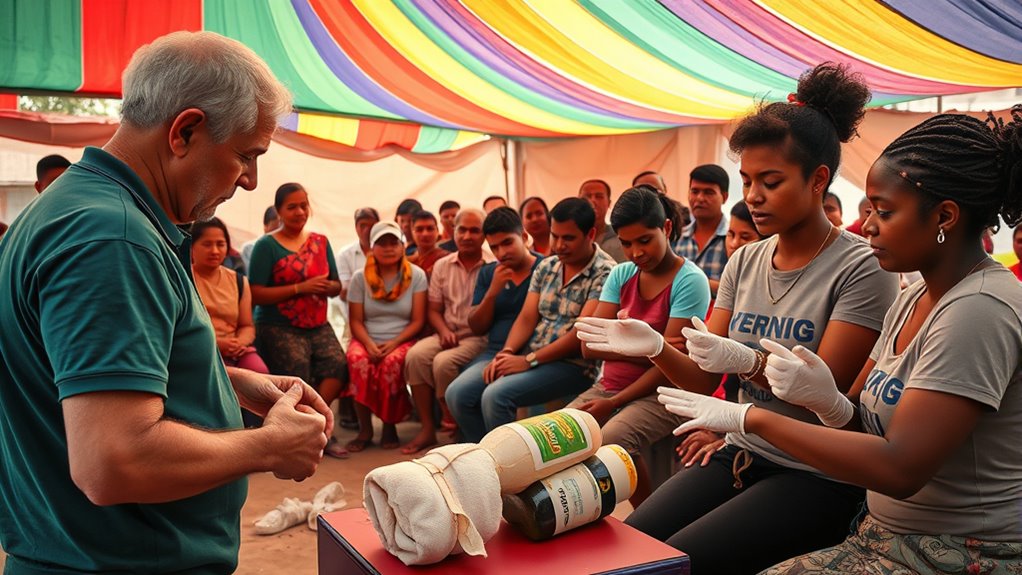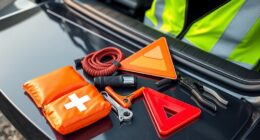To improve your basic first aid skills without spending much, explore free online tutorials, videos, and interactive courses that teach CPR, wound care, and choking relief. Practice with household items by creating simulations, like using pillows for sprains or ketchup for wounds, to build confidence. Joining local community workshops can also provide valuable hands-on experience at little or no cost. Keep exploring these low-cost options to become more prepared for emergencies.
Key Takeaways
- Utilize free online tutorials, videos, and interactive courses to learn essential first aid skills cost-effectively.
- Practice first aid techniques using household items and DIY simulations to reinforce learning without expenses.
- Join community training programs and workshops for affordable, hands-on first aid experience and skill development.
- Engage in community-based learning to access low-cost or free safety courses and foster collective emergency preparedness.
- Maintain a well-stocked, homemade first aid kit with inexpensive supplies and regularly practice emergency response drills.
Utilize Free Online Resources and Tutorials

If you’re looking to enhance your first aid skills without spending money, taking advantage of free online resources and tutorials is a smart choice. These materials help you improve your emergency preparedness by teaching you essential first aid techniques. You can find step-by-step guides, videos, and interactive courses that cover topics like CPR, wound care, and choking relief. Familiarizing yourself with these resources boosts your confidence to respond effectively during emergencies. Additionally, many tutorials emphasize the importance of maintaining a well-stocked first aid kit, which is vital for proper emergency response. Using free online content allows you to learn at your own pace, ensuring you’re better prepared to handle injuries or health crises with the right knowledge and skills.
Practice With Household Items and DIY Simulations

Practicing first aid techniques using household items and DIY simulations can considerably boost your confidence and preparedness. Engaging in simple first aid drills with everyday objects helps you stay calm during emergencies and reinforces household safety. Here are four impactful ways to practice:
Boost your confidence with DIY first aid drills using household items for quick, effective emergency response.
- Use a pillow to simulate a sprained ankle and practice wrapping it with a towel.
- Fill a plastic bag with ice to mimic cold compress applications.
- Create a mock wound with red tape or ketchup for bandaging practice.
- Use a stuffed animal to rehearse choking rescue techniques.
Additionally, household safety education encourages proactive injury prevention and enhances your overall readiness. These activities make learning realistic and cost-effective, empowering you to act quickly in real emergencies. Regular DIY simulations ensure you’re ready to handle injuries confidently while keeping safety top of mind.
Join Community Training Programs and Workshops

Joining community training programs and workshops offers an affordable way to learn essential first aid skills from experienced instructors. Many local volunteer groups organize these sessions during community safety events, making it easy to access quality training without high costs. Attending these programs helps you gain hands-on experience and confidence in handling emergencies. Plus, they often cover a wide range of topics, from CPR to wound care, tailored to your community’s needs. Participating in local workshops also connects you with neighbors who share your goal of enhancing safety. These events are typically low-cost or free, making them a budget-friendly option to improve your first aid knowledge. By engaging in community training, you turn a small investment into valuable lifesaving skills. Additionally, these programs often emphasize proper skin care and injury prevention, which are essential aspects of overall safety.
Frequently Asked Questions
How Often Should I Review My Basic First Aid Skills?
You should review your basic first aid skills at least every six months. Regular skill refreshers help keep your knowledge sharp and guarantee you’re prepared in an emergency. Setting a review frequency, like every three to six months, helps you stay confident and competent. Don’t wait too long; frequent practice ensures you remember key techniques and can act quickly when it matters most.
Are There Mobile Apps for Free First Aid Guidance?
Imagine having a lifeline in your pocket—yes, there are free first aid apps that serve as your digital safety net. These first aid apps provide instant access to free emergency guides, step-by-step instructions, and helpful tips during emergencies. They’re easy to download and use, ensuring you’re prepared when it matters most. With these apps, you can confidently handle minor injuries and know when to seek professional help.
Can I Get Certified Through Online First Aid Courses?
Yes, you can get certified through online first aid courses. Many reputable organizations offer online training that covers essential first aid skills and provides official First aid certification upon completion. These courses are convenient, affordable, and flexible, allowing you to learn at your own pace. Just verify the online training you choose is recognized by relevant health authorities or organizations to guarantee your certification is valid and credible.
What Are Common Mistakes to Avoid During Basic First Aid?
You should avoid common errors like moving an injured person unnecessarily or failing to call emergency services promptly. Be cautious of training pitfalls, such as overestimating your abilities or rushing through procedures. Remember, staying calm and following the correct steps are vital. Don’t skip evaluating the situation carefully or providing aid beyond your training. These mistakes can worsen the injury, so always prioritize safety and your knowledge during first aid.
How Do I Handle Emergencies in Remote or Underserved Areas?
When handling emergencies in remote areas, you should carry a well-stocked remote medical kit tailored for the environment. Use community training programs to build local first aid skills, empowering residents to respond effectively. Stay calm, assess the situation, and provide basic care while waiting for professional help. Your proactive preparation, including familiarizing yourself with essential first aid procedures, makes a significant difference in improving outcomes in underserved locations.
Conclusion
By taking advantage of free online tutorials, practicing with household items, and joining local workshops, you can considerably boost your first aid skills without breaking the bank. Remember, “A stitch in time saves nine,” so don’t wait until an emergency strikes—prepare yourself now with simple, cost-effective methods. With a little effort and resourcefulness, you can confidently handle basic injuries and potentially save lives when it matters most.










